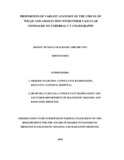Proportion of Variant Anatomy of the Circle of Willis and Association With Other Vascular Anomalies on Cerebral Ct Angiography
Abstract
BACKGROUND AND PURPOSE
There is a wide variation in the anatomy of the CW in different individuals and population groups. Knowledge of variant anatomy of the circle of Willis is important for general radiologists, interventional radiologists and neurosurgeons.
The purpose of this study was to determine the proportion of variant anatomy of the circle of Willis and association with other vascular anomalies in patients referred for cerebral CTA.
METHODOLOGY
This was a cross-sectional descriptive study conducted on 94 patients referred for cerebral CTA at the Kenyatta National Hospital and Nairobi Hospital from August 2017 to February 2018. MIP and 3D reformatted images were analyzed by two senior radiologists to determine the final configuration of the CW and presence of vascular pathology. A vessel with a diameter of <0.8 mm was considered to be absent or hypoplastic. Chen et al classification was used to determine the final configuration of CW. Final data analysis was done using Statistical Package for Social sciences Program (SPSS) version 20.0.
RESULTS
A complete CW was seen in 37.2% with a slightly higher prevalence in males than females (37.7% vs 36.6% p=0.909). Type A anterior CW variant was the commonest accounting for 78.7% of anterior variants while type E posterior variant was the dominant posterior variant at 41.5%.Fetal PCA was demonstrated in 25.5% with unilateral fetal PCA being more common than bilateral fetal PCA. Aneurysms were seen in 24.5% of patients with ACoA aneurysms being commonest at 43.6%.AVMs were seen in 8.5% of patients.
Azygous ACA, fenestration and duplication of vessels and persistent TA were not demonstrated. No significant association between aneurysms and CW configuration.
CONCLUSION
The variant anatomy of CW in patients undergoing cerebral CTA in this study are similar to other studies done in different population groups.
This study however demonstrates slight differences in proportion of variant anatomy of the circle of Willis which could be due to genetics, sample size and technique used.
No significant association was found between aneurysms and CW configuration. No association was demonstrated between AVMs and the CW configuration.
Publisher
University of Nairobi
Rights
Attribution-NonCommercial-NoDerivs 3.0 United StatesUsage Rights
http://creativecommons.org/licenses/by-nc-nd/3.0/us/Collections
The following license files are associated with this item:


